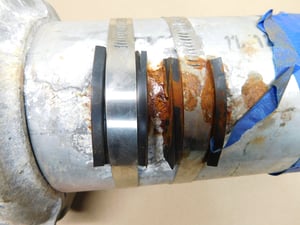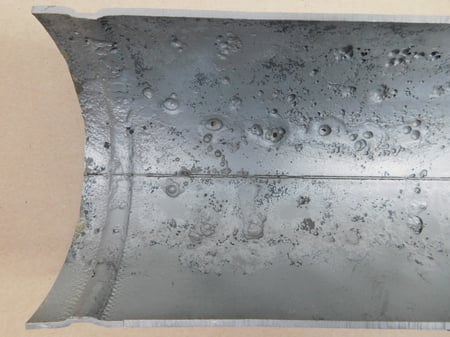Galvanized Steel Pipe Corrosion
For many years galvanized steel has been the preferred construction material for dry and pre-action fire sprinkler systems. Despite the added cost of using galvanized pipe in lieu of black steel pipe (typically a 30% premium), galvanized pipe was often specified for projects based on one primary assumption: that it provided better corrosion management and prevention, which would thereby result in an extended service life for the system.
However, feedback from installing contractors and building owners has shown that this assumption was wrong and that galvanized steel pipe may have been a misapplication of material selection.
FM Global has stated that in the presence of trapped water, galvanized pipe can experience failures in 2-3 years after installation (FM Global Property Loss Prevention Data Sheet 2-1 “Corrosion in Automatic Sprinkler Systems” October 2017). ECS has seen failures develop in as little as 12 months, with most systems developing failures within 5 years after installation.
Why Galvanized Steel Fails
Galvanized steel has been used successfully for corrosion prevention in numerous applications without experiencing rapid failure. Its thin zinc layer provides resistance to corrosion by two mechanisms:
- First, it acts as a sacrificial anode when attached to steel. It will corrode preferentially under corrosive conditions, thereby protecting the underlying steel.
- Second, in the presence of moisture, zinc reacts with oxygen and carbon dioxide from the air to form a protective coating of zinc carbonate (passivation) when it dries out. When it can dry out under atmospheric exposure, galvanized steel works quite well on guard rails, corrugated roofing, flag poles, and street signs by forming a protective coating of zinc carbonate.
So why does galvanized steel fail so quickly in the fire sprinkler industry?
Simply put, the passivating layer of zinc carbonate does not form when the zinc layer doesn't have a chance to dry.
 Despite the name, dry pipe fire sprinkler systems will always contain some amount of trapped water. No matter how well a system is pitched to drain, removing all the water introduced to dry and pre-action systems during hydrostatic and periodic trip testing is impossible.
Despite the name, dry pipe fire sprinkler systems will always contain some amount of trapped water. No matter how well a system is pitched to drain, removing all the water introduced to dry and pre-action systems during hydrostatic and periodic trip testing is impossible.
At the locations where trapped water is present, the protective zinc carbonate layer will not form. Rather, under consistently oxygenated and moist conditions, aggressive localized oxygen corrosion will dissolve the zinc layer and expose the underlying steel.
This corrosion results in the formation of iron oxides at the site of the initial penetration of the zinc layer. Under-deposit corrosion mechanisms result in a higher corrosion rate underneath the mound of iron oxides (tubercle), which in turn results in more iron oxides. This self-catalyzing process results in the rapid formation of a pit in the pipe wall, eventually resulting in a pin-hole leak (see photo above).
Black Steel: A Better Option
The highly localized metal loss seen in galvanized pipe is not typical in black steel piping. Black steel pipe in dry pipe systems experiences generalized metal loss and wall-thinning at any location where trapped water is present. While this corrosion can result in large amounts of iron oxides, it does not result in highly localized pitting and rapid development of leaks.
 |
| Highly localized corrosion in a galvanized pipe sample |
The life expectancy of black steel pipe dry and pre-action systems is significantly longer than galvanized pipe. Leaks typically do not develop until 15-20 years after initial installation. However, obstruction risk from the formation of iron oxides occurs well before leaks begin to develop.
Despite increasing awareness amongst installing contractors, specifying engineers, and governing bodies, galvanized pipe continues to be installed in some new dry and pre-action systems. In order to extend the useful service life of these systems, it is essential that a corrosion control strategy is deployed before significant damage occurs. Since it is nearly impossible to remove the trapped water from these systems, the only method to effectively prevent corrosion in galvanized steel pipe systems is to remove the corrosive element: oxygen.
Our Approach to DPNI Technology
ECS has developed Dry Pipe Nitrogen Inerting (DPNI) technology to quickly remove oxygen from inside a sprinkler system and prevent its re-entry, mitigating the risk of corrosion. For more information on the technology, read our guide to ECS nitrogen generators and venting devices below.


